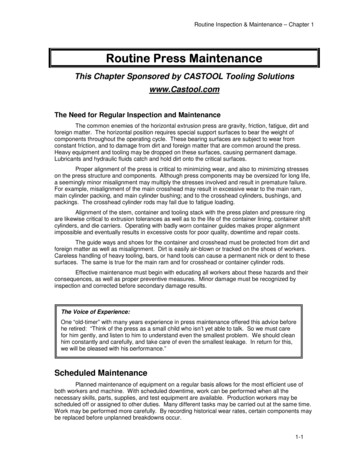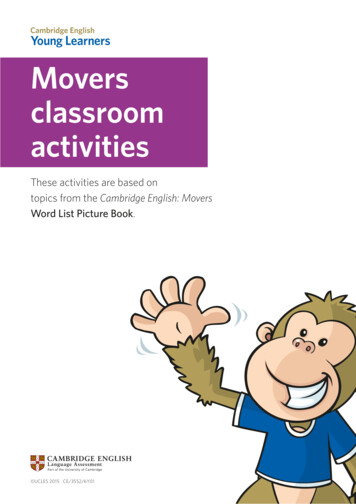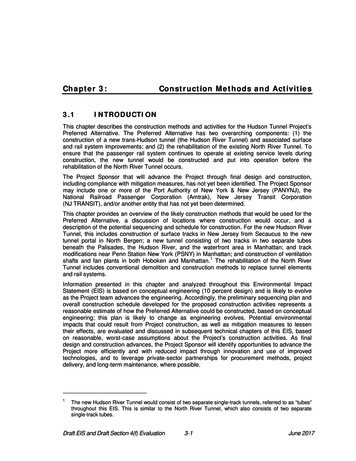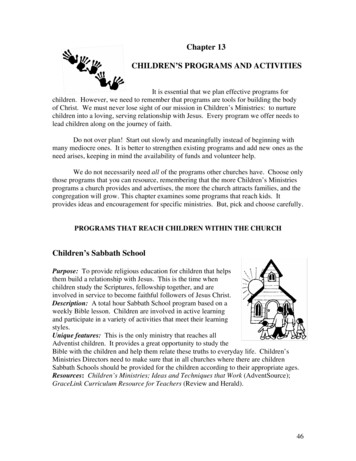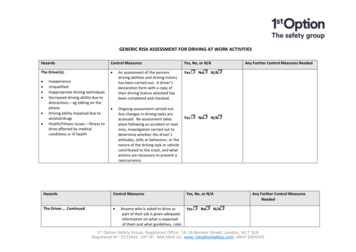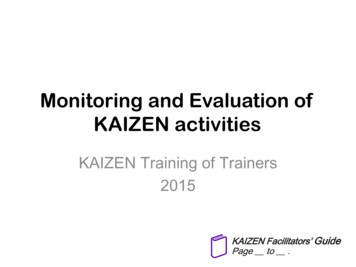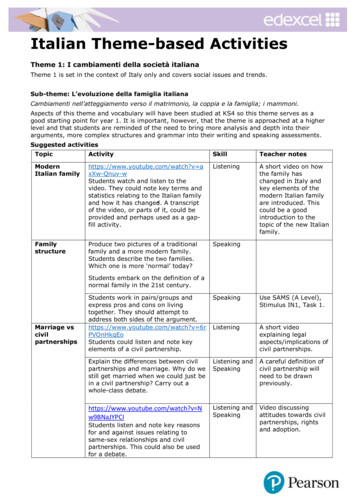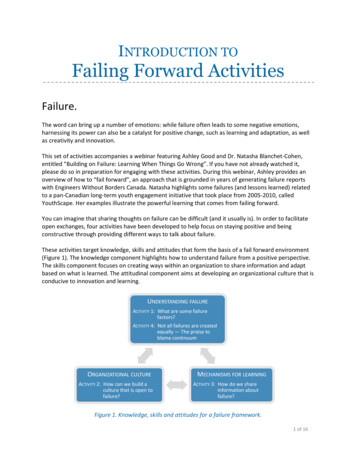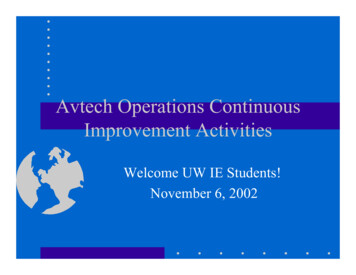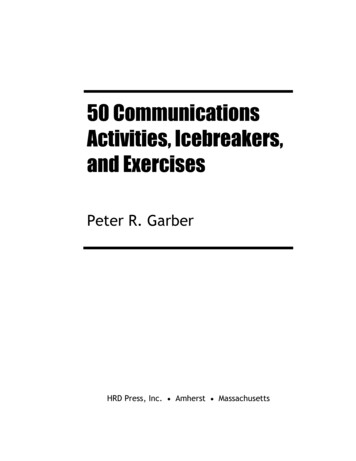
Transcription
50 CommunicationsActivities, Icebreakers,and ExercisesPeter R. GarberHRD Press, Inc. Amherst Massachusetts
Copyright 2008, Peter R. GarberThe materials that appear in this book, other than those quotedfrom prior sources, may be reproduced for educational/trainingactivities. There is no requirement to obtain special permissionfor such uses. We do, however, ask that the following statementappear on all reproductions.Reproduced from 50 Communications Activities,Icebreakers, and Exercises, by Peter R. Garber.Amherst, MA, HRD Press, 2008.This permission statement is limited to reproduction of materialsfor educational or training events. Systematic or large-scalereproduction or distribution—or inclusion of items in publicationsfor sale—may be carried out only with prior written permissionform the publisher.Published by:ISBNHRD Press, Inc.22 Amherst RoadAmherst, MA 010021-800-822-2801413-253-3488413-253-3490 (fax)www.hrdpress.com
ContentsPart I. Communications 7.18.19.Communications Is an Art.Communicating Time .Communications Is the Key.I Know You Believe You Understand .Communications Model.Listening Dilemma .Interactive Listening Tips.Listening Bad Habits .Listening Questionnaire .Seven Levels of Listening .Silent Messages .The Three Levels of Communications .Nonverbal Listening Test .Laws of Remembering .Laws of Forgetting .Meaning of Words .Communications Circles.Attention Spans .Meaning of Listening.371115192327313541454755596569737983Part II. Communications Icebreakers20.21.22.23.24.25.26.27.28.29.Vanity Name Cards.Repeating Introductions .Circle, Square, Triangle, or Z .Introducing Each Other .Fantasy Career .Name that Participant .Story of Your Name .Nickname Game .Introduction Bingo .Card Match .899193959799103105107111Part III. Communications Exercises30.31.32.33.Reading Test .The Longest Line .Color Block .Following Directions .iii125129133135
50 Communications Activities, Icebreakers, and .48.49.50.Train Story .Count the Ss .Communications Shutdowns.Repeat the Question.Quick Answers .Rephrasing Exercise .Wedding Story .Who Done It?.Picture Puzzle .Creative Fairy Tale .Rumors.The Shoe Store .Two Moose Sitting on a Log .Communications Styles.“Oh” .Word Games .Trading Cards 7227
PrefaceCommunications plays such a big part in our livestoday. It is hard to think of a single activity thatwe engage in that doesn’t involve communicationsin some way. In our busy world, we sometimesforget just how important communications are toour success, relationships, and, ultimately, happiness in life. But, indeed, communications doesplay a major role in achieving all of our goals.These 50 communications activities aredesigned to help participants become more awareand prepared to deal effectively with the manytypes of communications challenges they faceevery day. Each activity is designed to help participants better understand some facet of communications and gain expertise in that communications skill or competency. These activities willmake participants think about communications innew and different ways than they ever did before.They will also find these exercises not only usefulbut memorable as well.I hope you enjoy learning and presentingthese communications exercises as much as I haveover the past three decades of using them to helppeople become better communicators. Each istime tested and ageless. Have fun presentingthese activities along with those you present themto for many years to come.Peter R. Garberv
Part I:CommunicationsPrinciples
1. Communications Is an ArtDescription:This activity explains that communications ismuch more of an art than a science. There is noone right or wrong way to communicate—no setof absolute rules to be followed.Time Guideline:20 minutesPurpose:To emphasize to participants that each of uscommunicates in our own style and in ways mostcomfortable and effective for each of us. Likeart, communications can take on unlimited formsand variations, each unique to the personengaged in the communications.Resources:Handout 1-APresentation:1. Present Handout 1-A to participants.2. Ask participants if they agree or disagree withthis statement and why.3. Explain that communications does havecertain principles and procedures (see otheractivities in Part I of this activity book). Thereare specific, sound principles and themes, butthousands of variations.4. However, there is no right or wrong way tocommunicate effectively.5. Everyone has their own communications style,and there are thousands and thousands ofvariations to effective communications. Whatis most important is that people communicatein a sincere and honest manner with oneanother, in a style in which they are mostcomfortable. Few if any people cancommunicate effectively in a manner or stylethat does not fit them personally or naturally.Debrief:Ask participants if they have ever tried tocommunicate in a manner or style that was notnatural to them, and, if so, how difficult was itto do this effectively.3
50 Communications Activities, Icebreakers, and ExercisesDifficulty Rating:LowVariations:Before showing or sharing Handout 1-A, ask participants if they believe communications is morean art or a science. If you hear the responsefrom participants that they think communications is more of a science, ask them why theyfeel this way. Ask them what would define something as a science. Expect to hear commentsthat use terms such as consistent, exacting, etc.Ask if they feel that communications wouldreally be defined in this way.4
Handout1-ACommunicationsis much more ofan art than ascience.5
2. Communicating TimeDescription:The amount of time we spend communicatingwith others is presented in this activity.Time Guideline:20 minutesPurpose:To highlight the great amount of time weactually spend communicating with othersResources:Handout 2-APresentation:1. Ask participants how much time they thinkthey actually spend communicating withothers.2. Allow the group to provide their estimates.Write the estimates on a flipchart or piece ofpaper.3. Present Handout 2-A. Emphasize the statisticspresented in this handout: 70% of your totalwaking time is spent communicating in somemanner. Of this time you spend communicating, you spend approximately 16% reading, 9%writing, 30% talking, and 45% listening.4. Ask participants if they are surprised by theseestimates of the average time that peoplespend communicating, especially the 45% listening statistic.5. Point out that these percentages may varyfrom person to person. For example, somepeople may spend much more than 30% oftheir communications time talking and muchless time listening!Debrief:Explain that looking at these statistics, it makeseven more sense that we should strive to constantly become better communicators. Ourcommunications skills play an important part inour success and even happiness in life. Ask participants to think about how much communications time they actually spend on each of the7
50 Communications Activities, Icebreakers, and Exercisescommunications activities described in thisactivity. Ask them how changing these balancesof time in each of these communications couldmake a difference in their lives.Difficulty Rating:Low to medium8
Handout2-AHow do we spend our communications time?We spend approximately 70% of our time communicating withothers.Of this communications time, we spend:16% Reading9% Writing30% Talking45% Listening9
3. Communications Is the KeyDescription:This activity consists of an interactive discussionabout the importance of communications in theworkplace.Time Guideline:20 minutesPurpose:To highlight the importance of communicationsin solving problems at workResources:Handout 3-APresentation:1. Present Handout 3-A, which states the following: Communications is the key to achievingall of our goals.2. Ask participants if they agree or disagree withthis statement. You can expect that all ormost participants will agree with this statement.3. Ask participants why they believe this is true.Expect participants to volunteer any numberof reasons.4. Ask participants if they can think of a situation or problem in which communications wasnot critically important.5. Challenge participants to thoroughly explainhow better communications would not benecessary to correct the situation or problem.Debrief:Emphasize again that communications affectsvirtually everything that happens in organizations. Communications can be one of the greatest strengths of an organization or one of its biggest weaknesses. Ask participants to specificallydiscuss how communications is important in theirjobs.Difficulty Rating:Low11
50 Communications Activities, Icebreakers, and ExercisesVariations:Ask participants to share situations, problems,and challenges at work in which communicationsplayed a critical role, both in the cause andsolution.12
Handout3-ACommunicationsis the key toachieving all ofour goals.13
4. I Know You BelieveYou UnderstandDescription:A quote is presented to participants, and theyare asked to explain what they believe itsmeaning is.Time Guideline:20 minutesPurpose:To highlight how unclear communications canlead to confusing interpretations and toemphasize the need for clarity whencommunicatingResources:Handout 4-APresentation:1. Present Handout 4-A to participants and askthem what they think the statement means.2. Expect participants to have differinginterpretations, if any, of this very confusingstatement.3. There obviously is not a clear explanation forthis statement. Apparently, this speaker wastrying to say something about beingmisunderstood, but it is unclear what he orshe was really trying to say.4. Reveal the source of this quote and expectcomments from participants about trying tocommunicate with a government agency orofficial to resolve a problem or to cut throughgovernment red tape.Debrief:Discuss what problems are created by thesetypes of communications. Emphasize how muchconfusion ambiguous communications like thiscan cause in an organization. Ask participants toremember this quote when they arecommunicating with others as an example ofhow important clarify of communication is tobeing understood.15
50 Communications Activities, Icebreakers, and ExercisesDifficulty Rating:Low to mediumVariations:Use your own choice of confusing quote or askparticipants to share some confusing quotes theyknow of.16
Handout4-A“I know that you believe youunderstand what you think I said,but I am not sure you realize thatwhat you heard is not what Imeant!”Quote from a U.S. government official17
5. Communications ModelDescription:A communications model is presented to helpparticipants better understand what actuallyneeds to occur for effective communications toexist.Time Guideline:30 minutesPurpose:To provide a conceptual model for participantsto follow to help them become bettercommunicatorsResources:Handout 5-APresentation:1. Present Handout 5-A and explain that thisrepresents a model showing how effectivecommunications can be achieved. Althoughthis may seem like a cumbersome process togo through, this model is used in some manner by many people in all of their communications.2. Go through the four steps shown in themodel. Highlight that in this model there is aSENDER and a RECEIVER.3. Start with the SENDER, and point out that thefirst step in the com
50 Communications Activities, Icebreakers, and Exercises 4 Difficulty Rating: Low Variations: Before showing or sharing Handout 1-A, ask par- ticipants if they believe communications is moreFile Size: 1MBPage Count: 248
